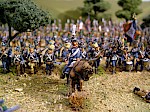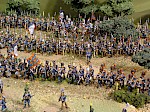The words of Goldsworthy (part 2)
 In part 1 , Adrian covered numerous aspects of the differences between the reality of battle and the wargames table for the ancient world. Next, he turned his attention to the black powder era.
In part 1 , Adrian covered numerous aspects of the differences between the reality of battle and the wargames table for the ancient world. Next, he turned his attention to the black powder era.
For the Napoleonic period, he addressed the myth of the bayonet charge. While vicious close combat happened in sieges and town fighting, they simply did not happen on the field of battle (with rare exceptions). If you charged an enemy they would typically flee (usually reforming) or give fire, which in turn would cause your troops to halt short of the enemy and return fire. In fact, when attacking, it was a difficult job for a commander to get his men to move forward. Attacking troops were usually told not to fire their muskets, as to return fire with the enemy would cause the attack to halt. Numerous battles would result in charges being halted and turned into an exchange of fire, while the commander would try to get his men to stop firing and prepare to charge again.
Regarding command and control, some people have argued that commanders would not be concerned below divisional level (quoting a recent article from a wargames magazine). Adrian countered this notion by stating that a general would do his utmost to be informed of the situation of his battalions, intervening where necessary or ensuring his subordinates were in control of the situation. His main reference concerned Wellington, but he also gave examples from Caesar’s commentaries. The presence of a supreme commander could do much to ensure troops were in the correct formation. However, he noted that a commander could not be everywhere, giving the example of a unit at Waterloo which was ordered to form up in square formation and effectively stayed in that position for the rest of the battle.
 Adrian prefers systems with individual casualty removal, as you can see the degradation of the unit. It should also reflect in combat that the unit is not fighting as well (something he noted that Warhammer Ancient Battles does fairly well and better than most). He suggested the trend towards single element systems, such as Impetus and Black Powder. He understood the logic behind this trend, but disliked the fact that a unit is either “there” and fighting at full capacity or “not there” and removed. He did say that the “clash” and “sustained” concepts in Hail Caesar were some way towards a solution.
Adrian prefers systems with individual casualty removal, as you can see the degradation of the unit. It should also reflect in combat that the unit is not fighting as well (something he noted that Warhammer Ancient Battles does fairly well and better than most). He suggested the trend towards single element systems, such as Impetus and Black Powder. He understood the logic behind this trend, but disliked the fact that a unit is either “there” and fighting at full capacity or “not there” and removed. He did say that the “clash” and “sustained” concepts in Hail Caesar were some way towards a solution.
Adrian Goldsworthy covered a great deal more, with which I could probably fill a dozen blog posts. Suffice to say that when we stopped after a long question and answer session, one and a half hours had passed. The one thing that stood out for me was the difficulty a commander has to get his troops to engage in close combat: self-preservation is indeed nature’s first law and killing becomes easier the further removed a soldier is from his victim. It is easier to shoot a target at distance than close to bloody combat with a bayonet. I was reminded of a quote from the Winter War: a veteran was asked about heroes. He said “They are all still there”, as in still on – or now under – the battlefield.
